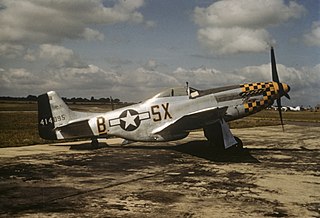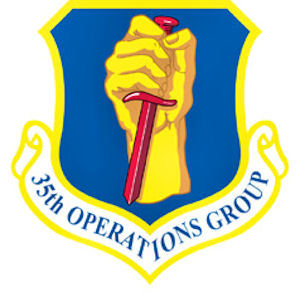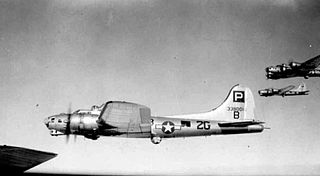
The 113th Operations Group is a flying group of the United States Air Force. It provides air sovereignty forces to defend District of Columbia and also provides fighter, airlift and support forces capable of local, national and global employment.

The 306th Flying Training Group is a unit of the United States Air Force, assigned to Air Education and Training Command (AETC). The group is stationed at the United States Air Force Academy (USAFA) near Colorado Springs, Colorado.

George Earl Preddy Jr. was a United States Army Air Forces officer during World War II and an American ace credited with 26.83 enemy air-to-air kills, ranking him as the top P-51 Mustang ace of World War II and eighth on the list of highest scoring American aces.

Royal Air Force Wormingford, or more simply RAF Wormingford, is a former Royal Air Force station located 6 miles (9.7 km) northwest of Colchester, Essex, England.

The 487th Air Expeditionary Wing is a provisional United States Air Force unit assigned to the United States Air Forces in Europe. As a provisional unit, it may be activated or inactivated at any time. The unit's last known assignment was in 2003 at Cairo West Air Base, Egypt, during Operation Iraqi Freedom.

The Commandant of Cadets is a named organization of the United States Air Force based at the Air Force Academy in Colorado Springs, Colorado. Until August 2006 the commander of the 34th Training Wing was "dual-hatted" as the Commandant of Cadets at the Academy. In that month the 34th Wing became a named organization.

The 95th Fighter Squadron, nicknamed the Boneheads, is an active squadron of the United States Air Force. Last activated on 15 June 2023 as a Lockheed Martin F-35 squadron stationed at Tyndall Air Force Base, Florida. Previously the 95 FS was an F-22 equipped squadron, but in 2019 the squadron's aircraft and personnel were distributed across other bases in the aftermath of Hurricane Michael in 2018 and its destruction of large parts of Tyndall Air Force Base. It was subsequently disbanded in 2019. In August 2023, the unit received its first Lockheed Martin F-35A Lightning II aircraft.

The 149th Fighter Squadron is a unit of the Virginia Air National Guard's 192d Fighter Wing located at Joint Base Langley–Eustis, Virginia. The 149th is the first Air National Guard fighter squadron to fly the F-22 Raptor.

The 353rd Fighter Group, nicknamed the Slybird Group, was a fighter group of the United States Army Air Forces during World War II. The group was stationed in England and comprised the 350th, 351st, and 352nd Fighter Squadrons. It pioneered the P-47 dive-bombing and ground attack technique adopted by both Eighth and Ninth Air Forces. The group flew 447 combat missions and claimed 330 air and 414 ground aircraft destroyed. Group markings were black, yellow, black, yellow spinners, with a 48-inch black and yellow checker band around the cowling to the end of the exhaust stubs.

The 96th Flying Training Squadron is part of the 340th Flying Training Group and is the reserve associate to the 47th Flying Training Wing based at Laughlin Air Force Base, Texas. It operates T-1 Jayhawk, T-6 Texan II, and T-38 Talon aircraft conducting flight training.

The 86th Fighter-Interceptor Squadron is an inactive United States Air Force unit. Its last assignment was with the 79th Fighter Group at Youngstown Air Force Base, Ohio, where it was inactivated on 1 March 1960.

The 31st Operations Group is the flying component of the 31st Fighter Wing, assigned to the United States Air Forces in Europe. It is stationed at Aviano Air Base, Italy.

The 20th Operations Group is the flying component of the 20th Fighter Wing, assigned to the United States Air Force Air Combat Command. It is stationed at Shaw Air Force Base, South Carolina. It is a successor organization of the 20th Pursuit Group, one of the 15 original combat air groups formed by the U.S. Army before World War II.
Zutendaal Air Base is a reserve Belgian Air Component base, located 4 mi (6.4 km) east-southeast of Genk (Limburg), approximately 50 mi (80 km) east-northeast of Brussels.

The 35th Operations Group is the operational flying component of the United States Air Force 35th Fighter Wing. It is stationed at Misawa Air Base, Japan, and is a part of Pacific Air Forces (PACAF).

The United States Air Force's 66th Weapons Squadron is a United States Air Force Weapons School Fairchild Republic A-10 Thunderbolt II instructional flying unit, at Nellis Air Force Base, Nevada.

The 836th Bombardment Squadron was a United States Army Air Forces unit. It was activated in September 1943. After training in the United States, it deployed to the European Theater of Operations, where it engaged in combat in the strategic bombing campaign against Germany with Consolidated B-24 Liberators. In the summer of 1944, it was withdrawn from combat to convert to the Boeing B-17 Flying Fortress, then continued in combat with the 487th Bombardment Group until the spring of 1945. Following V-E Day, the squadron returned to Drew Field, Florida, where it was inactivated on 7 November 1945.

The 486th Fighter Squadron is an inactive United States Air Force unit. It activated during World War II and was assigned to the 352nd Fighter Group of VIII Fighter Command. After training in the United States, it deployed to the European Theater of Operations, where it earned a Distinguished Unit Citation and a French Croix de Guerre with Palm for its combat actions. Following V-E Day, it returned to the United States and was inactivated at the port of embarkation, Camp Kilmer, New Jersey, on 9 November 1945.

The 352nd Fighter Group was a unit of the Eighth Air Force that was located in the European Theater of Operations during World War II. The unit served as bomber escort, counter-air patrols, and attacking ground targets. It initially flew P-47 Thunderbolt aircraft before converting to P-51 Mustang in April 1944. The group was located at RAF Bodney in England for the majority of its service and were nicknamed the Blue-nosed Bastards of Bodney due to the distinctive blue of the nose and upper cowl of the P-51 Mustangs of the group.

William Thomas Whisner Jr. was a career officer and pilot in the United States Air Force, retiring as a colonel with 30 years of military service. He was a fighter ace with Army Air Forces over Europe in World War II and a jet fighter ace with the Air Force in the Korean War.





















